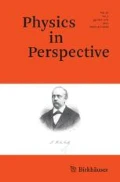Abstract
Theoretical physicist Edward Gerjuoy discusses his family background, elementary and secondary education in Brooklyn, New York, undergraduate studies at City College, graduate work at the University of California at Berkeley, research during World War II, and subsequent career at the University of Southern California, New York University, the General Atomics Laboratory, the Radio Corporation of America, and the University of Pittsburgh, as well as his work as a lawyer and service as a judge on the Pennsylvania Environmental Hearing Board in Pittsburgh.







Similar content being viewed by others
Notes
Two other places were the University of Minnesota where John H. Van Vleck taught from 1923 to 1928, and the University of Wisconsin where he taught from 1928 to 1934.
These included the APS Panel on Public Affairs (1976–1979, 1981, 1994–1996), the Committee on the International Freedom of Scientists (1978–1980, 1984–1985, 2003–2006), the Constitution and Bylaws Committee (1999–2002), Audit Committee (2002–2004), and Sakharov Prize Committee (2005–2007), as well as serving as an officer and chair of the Forum on Physics and Society (1994–1997) and as a member of the Council (2000–2003).
References
E. Gerjuoy, “On the Angular Distribution in the Reaction F19(p,α),” The Physical Review 58 (1940), 503–505.
E. Gerjuoy, “Interference in the Zeeman Effect of Forbidden Lines,” Phys. Rev. 60 (1941), 233–240.
Max Born, My Life: Recollections of a Nobel Laureate (New York: Charles Scribner’s Sons, 1978), p. 229.
Leonard I. Schiff, Quantum Mechanics (New York, Toronto, London: McGraw-Hill, 1949). Prior to the war, at least four others were published: Arthur Edward Ruark and Harold Clayton Urey, Atoms, Molecules and Quanta (New York and London: McGraw Hill, 1930); Linus Pauling and Samuel Goudsmit, The Structure of Line Spectra (New York and London: McGraw Hill, 1930); Linus Pauling and E. Bright Wilson, Introduction to Quantum Mechanics With Applications to Chemistry (New York and London: McGraw Hill, 1935); and Edwin C. Kemble, The Fundamental Principles of Quantum Mechanics (New York and London: McGraw Hill, 1937).
Gerjuoy, “Angular Distribution” (ref. 1); Gerjuoy, “Interference” (ref. 2); Edward Gerjuoy and Julian Schwinger, “On Tensor Forces and the Theory of Light Nuclei,” Phys. Rev. 61 (1942), 138–146.
Edward Gerjuoy, “Oppenheimer as a Teacher of Physics and Ph.D. Advisor,” in Cynthia C. Kelly, ed., Oppenheimer and the Manhattan Project: Insights into J. Robert Oppenheimer,“Father of the Atomic Bomb” (New Jersey, London, Singapore: World Scientific, 2006), pp. 119–140.
Richard C. Tolman, Relativity Thermodynamics and Cosmology (Oxford: Clarendon Press, 1934).
H.A. Bethe and J. Robert Oppenheimer, “Reaction of Radiation on Electron Scattering and Heitler’s Theory of Radiation Damping,” Phys. Rev. 70 (1946), 451–458; H.W. Lewis, J.R. Oppenheimer, and S.A. Wouthuysen, “The Multiple Production of Mesons,” ibid. 73 (1948), 127–140; S.T. Epstein, R.J. Finkelstein, and J.R. Oppenheimer, “Note on Stimulated Decay of Negative Mesons,” ibid. 73 (1948), 1140–1141; Sin-Itiro Tomonaga and J.R. Oppenheimer, “On Infinite Field Reactions in Quantum Field Theory,” ibid. 74 (1948), 224–225.
Edward Gerjuoy and A. Theodore Forrester, “Possible Use of Thermal Noise for Low Temperature Thermometry,” Phys. Rev. 71 (1947), 375–376; A. Theodore Forrester, William E. Parkins, and Edward Gerjuoy, “On the Possibility of Observing Beat Frequencies between Lines in the Visible Spectrum,” ibid. 72 (1947), 728; Edward Gerjuoy, A. Theodore Forrester, and William E. Parkins, “Signal-to-Noise Ratio in Photoelectrically Observed Beats,” ibid. 73 (1948), 922–923.
David Halliday, Introductory Nuclear Physics (New York: John Wiley & Sons and London: Chapman & Hall, 1950).
E. Gerjuoy and Sadhan K. Adhikari, “Nonuniqueness of solutions to the Lippmann-Schwinger equation in a soluble three-body model,” Phys. Rev. A 31 (1985), 2005–2019; idem, “Alternative interpretations of the many-particle Lippmann-Schwinger equation,” Phys. Rev. C 34 (1986), 1–13; E. Gerjuoy, “Comment on ‘Triad of three-particle Lippmann-Schwinger equations,” ibid., 1143–1148.
Edward Gerjuoy, “Lower Bound on Entanglement of Formation for the Qubit-qudit System,” Phys. Rev. A 67 (2003), 052308-1–052308-10; idem, Shor’s factoring algorithm and modern cryptography. An illustration of the capabilities inherent in quantum computers,” American Journal of Physics 73 (2005), 521–540; Edward Gerjuoy and Andrew Sessler, “Popper’s experiment and communication,” ibid. 74 (2006), 643–648; Edward Gerjuoy, P.S. Bourdon, J.P. McDonald, and H.T. Williams, “Deterministic dense coding and entanglement entropy,” Phys. Rev. A 77 (2008), 22305-1–22305-16; Edward Gerjuoy, H.T. Williams, and P.S. Bourdon, “Augmented message-matrix approach in deterministic dense-coding theory,” ibid 79 (2009), 042315-1–02315-8; Edward Gerjuoy and P.S. Bourdon, “Overcoming a limitation of deterministic dense coding with a nonmaximally entangled initial state,” ibid. 81 (2010), 022314-1–22314-11.
For example, Edward Gerjuoy, “Science and Technology Resources for the Courts,” The Justice System Journal 14 (1991), 358–382; idem, “Electromagnetic Fields: Physics, Biology and Law,” Jurimetrics Journal of Law, Science and Technology 35 (1994), 55–75.
Acknowledgment
Cooper and Gerjuoy, jointly and separately, sincerely thank Roger H. Stuewer for his careful, intelligent editing of the interview manuscript and for adding the references and figures, which surely has increased the interview’s readability and interest.
Author information
Authors and Affiliations
Additional information
Address requests for reprints to Edward Gerjuoy, Department of Physics and Astronomy, 100 Allen Hall, University of Pittsburgh, 3941 O’Hara Street, Pittsburgh, PA 15260, e-mail: gerjuoy@pitt.edu.
David K.C. Cooper, Ph.D., M.D., is Professor of Surgery in the School of Medicine of the University of Pittsburgh.
Rights and permissions
About this article
Cite this article
Cooper, D.K.C. Edward Gerjuoy: From Physics to Law and Back Again. Phys. Perspect. 13, 433–455 (2011). https://doi.org/10.1007/s00016-011-0072-7
Published:
Issue Date:
DOI: https://doi.org/10.1007/s00016-011-0072-7
Keywords
- Edward Gerjuoy
- Raymond T. Birge
- Max Born
- David Halliday
- Otto Halpern
- Ernest O. Lawrence
- J. Robert Oppenheimer
- Robert Serber
- Leo Sapirstein
- Leonard Schiff
- Julian Schwinger
- Lyman Spitzer
- Richard Thornburgh
- City College
- University of California at Berkeley
- Sonar Analysis Group
- University of Southern California
- New York University
- University of Pittsburgh
- General Atomics Laboratory
- Radio Corporation of America
- Hastings College of Law
- Pennsylvania Environmental Hearing Board
- Rose Schmidt law firm
- Los Alamos
- American Physical Society
- Nobel Prize
- antisubmarine warfare
- theoretical physics
- quantum computing
- science and law
- human rights




